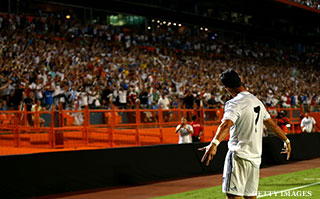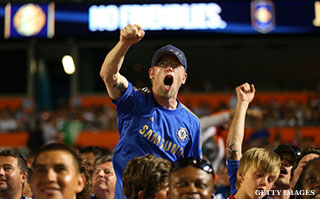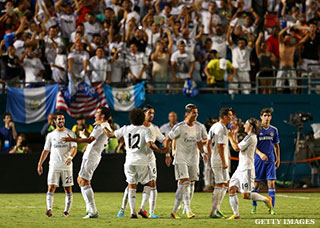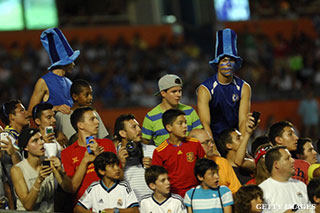
MIAMI -- The absence of an audio assault takes longer to notice than you'd expect. Somewhere between soccer mega star Cristiano Ronaldo's first goal, a vintage Barry Zito curveball over a lineup of Chelsea defenders on a free kick, and his second, a sprinting header through three men, the lack of the usual volley of volume by the stadium's sound operator dawns on me.
Gone are the drum-beat prompts that attempt to start a "defense" chant. Likewise, the synthesized horns that signal fans to yell "charge" are nowhere to be found. The music supervisor for Sun Life Stadium has mercifully left the Jock Jams playlist at home and a prerecorded team theme song has yet to be played during the match. No announcer shrieked a soccer version of "Another [insert your team here] first down!" after every positive outcome for either team.
In place of all these things are actual cheers. Unsolicited, unabashed, unscheduled cheers. Whistles and chants and claps and legitimate "oohs" and "aahs" and boos and rowdy taunts are heard when, and only when, the on-field play deserves it. It's entirely organic and completely refreshing. It's a major sporting event that treats adults like adults. It's fandom without training wheels.
And maybe that's exactly why soccer's window of opportunity in America appears to be opening -- it is inherently free of so many of the most popular annoyances hoisted upon us by the owners of our favorite sports.
"Dude, this TV timeout is taking FOREVER," is a phrase uttered by nobody at Sun Life Stadium during the finals of the Guinness International Champions Cup because there weren't any.
"How many timeouts is this coach going to call? Just play the damn game!" is a complaint shouted by zero people.
"This instant replay review is longer than Man of Steel. We all know it's a first down. Let's go!" was not thought by a single fan in the stadium.
"If the manager changes pitchers again, or visits the mound for a conference call longer than my dentist appointment, I'm going to let Cliff Lee throw a fastball into my groin just to see an actual pitch," is a feeling that nobody watching Chelsea versus Real Madrid had.

"These last two minutes feel like two years." "How many fouls is Joey Crawford going to call?" "Two time outs to freeze the kicker? Two?!" "If David Ortiz steps out of the batter's box to spit on his hands one more time I'm putting my head through the TV!" The list of complaints that have become commonplace in the American sports landscape are endless.
Soccer, just maybe, offers salvation. At least that's what many in the sports entertainment world are counting on.
If you haven't heard, NBC Universal recently signed a three-year deal with the English Premier League worth around $250 million. They're going to broadcast nearly 400 soccer games across their networks during the league's 10-month season. Here at home, Major League Soccer just announced plans to expand to four more cities by the year 2020, giving the league 24 teams. As for the coveted Millennial generation's interest in the sport, you need only to look at the crowded soccer fields in your home town every weekend or EA Sports' FIFA soccer franchise, which was a top 10 selling video game in 2012.
Yes, it has been declared that the carcass of American soccer fans has had a pulse before, but to the casual sports fan, there have never been so many out-in-the-open displays of soccer love, both from fans and corporations. It also helps that the U.S. men's national team is on an unprecedented winning streak going into its final World Cup qualifiers, rendering the usual anti-soccer fan retort of "we suck at soccer" almost moot. We even have our own somewhat global stars in Landon Donovan and the recently-returned-to-MLS-from-the-EPL, Clint Dempsey.
Is now really, finally, truly the time for soccer's rise in the States?
Approaching Sun Life Stadium before the semifinals and finals of the Championship Cup feels nearly identical to the dozens of times I've made the same walk for Miami Dolphins games or Miami Hurricanes games. People are grilling, people are wearing jerseys and people are kicking (rather than throwing) a ball around. Admittedly, there are enough languages being spoken and nationalities being represented to make it feel like the United Nations is hosting a tailgate, but the pre-game buildup for fans is almost exactly the same, with an equal level of fanaticism on display.
So many AC Milan fans are sporting mohawks or bro-hawks or faux-hawks that you'd think a Mr. T tribute band was playing inside (sadly, this wasn't the case, as the mohawks were mostly in honor of Milan's Mario Balotelli). Then there are the flags, unfurling as far as the eye can see.
Chelsea. AC Milan. LA Galaxy. Real Madrid. Everton. The flags are everywhere, waving and flapping and spurring chants among random fans carrying the same flag. The overall atmosphere has a whiff of big-time college football with a dash of Olympic spirit. It's a passion any sports fan would recognize, and frankly, there is no doubt far more buzz in the air for these games than your average Dolphins vs. Bills game, a fact that I'm sure wasn't lost on Dolphins owner Stephen Ross, the man responsible for bringing the final round of the cup to Miami.

Then again, it doesn't hurt having world-famous Cristiano Ronaldo scheduled to play instead of Dolphins QB Ryan Tannehill, who could probably order a pound of turkey at a Publix Deli in Fort Lauderdale without so much as a head nod from the meat slicer.
In the end, it's all about the product on the field, and when the product is good, as it is with La Liga, the European powerhouses and an increasing number of MLS franchises, fans will come. Of course, using what amounts to an international all-star game in one of America's most diverse cities as a barometer has its drawbacks, but it is a decent way to see what can happen if soccer in general, and the MLS in particular, can cultivate a rabid American fan base.
On the flip side, the NFL, NBA, MLB and many of the non-original six NHL teams are quietly struggling to fill their seats, despite having far and away the best athletes in their respective sports playing every night. The reasons for this cover so many topics you'd need a string theory to tie them together, from the amazing at-home viewing experiences, to the high ticket prices, to the insane food and beer prices, to the economy in general, crappy teams, parking problems, traffic, no star power on a team, hatred for an owner and on and on ...
So while the "fan experience" has no doubt improved from a bells and whistles standpoint at all the new stadiums being built, the fact that fewer fans want to go to the games is a bit of a buzz kill. Whether it's the Dallas Cowboys' 11,500 square foot high definition Jumbotron or putting a pool behind an outfield wall so you can watch a no-hitter on a wet noodle, owners of the big three sports in the United States are increasingly feeling that they need way more than just the product on the field to keep fans coming back.
Soccer's approach in the United States, from bringing in the best teams to events like the International Champions Cup to making a concerted effort to lure more international stars to the MLS, appears to be the opposite: improve the quality of play available to US viewers at all costs. If soccer can manage to avoid the pitfalls that have stunted attendance in other sports, and keep its eye on the ball by not messing with the actual play on the field, then the sky is the limit. This means maintaining reasonable ticket prices, and making the game itself the focus of the activity in person, while keeping it to a reasonable length with minimal stoppages for the at-home viewer,
This potential is why 65,000 people showed up to watch Cristiano Ronaldo in person. That's why the Seattle Sounders spent $9 million on the rights to Clint Dempsey. That's why NBC spent a quarter of a billion dollars for the rights to air the EPL. There is simply no substitute for viewing the best in the world do what they do best.

Unfortunately, the owners of the big three American sports teams have let too many factors not integral to the sport get in the way of the game, and rather than be forced to sit through the endless TV delays and side shows and Kiss Cams and T-shirt cannons and decibel drubbings at the hands of stadium operators intent on having a Jay-Z concert and a circus seem to break out every time the play is stopped, fans are choosing to stay home. There they can control their own experience and simply change the channel to another game or show, without the hassle and expense of going to the event in person.
Perhaps, into this void, a sport will emerge as the last American past time where fans can still go to a game to simply watch the game, and where adults aren't subjected to an onslaught of stadium instructions on how to cheer and when and what to say. Perhaps that sport will be soccer. Perhaps that time is now.
-- Jon Finkel is the author of The Dadvantage: Stay In Shape On No Sleep With No Time And No Equipment. Follow him on Twitter @Jon_Finkel.




